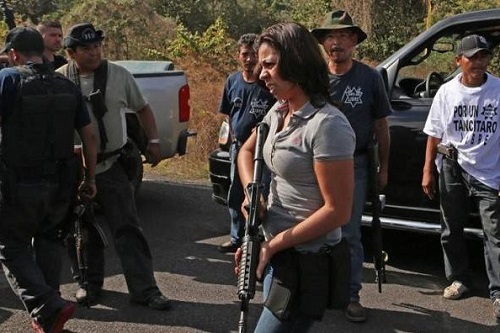AP photo
By
Ricardo Swire
Mexico’s unregulated vigilante militias’ four year growth has created a “third force” in the country’s cartel violence, in nine of thirty-one states armed civilian groups multiplying.
Criminal infiltration manipulated the militias’ standard modus operandi to reflect ongoing rival cartel clashes. Several vigilante militias imitate the language and code of community police, although not from or residing in the neighborhood. Mexico’s Center for Research & National Security (CISEN) noted over ten years residents in Veracruz state witnessed a minimum two thousand seven hundred disappearances.
Locals saw the former six year Veracruz Governor turned fugitive on multiple embezzlement charges worth US$20 million. La Compañía, or the forerunner of Los Zetas cartel, enjoyed a lucrative agreement with Veracruz political elites. La Compañía’s executives financed local partisan campaigns, in exchange for protected drugs passage through the state, José Cardel, strategically situated halfway between state capital Xalapa and port of Veracruz, regarded the main hub for Los Zetas’ kidnapping and sex trafficking operations. One Veracruz State Attorney Office (FGE) case officer stated from 2011 to 2013 he alone processed one thousand criminal complaints concerning disappearances.
Mexico’s National Institute for Statistics & Geography calculated unreported crime in Veracruz state represent ninety-four point six percent of total violations. Analysis found correlation between Mexico’s public security militarization and the spike in human rights abuses by police and army personnel. Most Mexican resources are concentrated at the Federal level, a practice that sidelined investments in and reforms of domestic security units. The resulting shortage of equipment and training encouraged several local and state enforcement entities to regard confronting bandit vigilante militia groups as impossible and outside their mandates.
The reality of such criminal power made apparent when a FGE agent, newly transferred to the south Veracruz office, was kidnapped and beaten by Los Zetas enforcers. Shortly after his arrival the agent was responsible for the arrest of several Los Zetas felons. One of the cartel’s commander visited the police station and demanded release of “his boys.” The FGE agent’s supervisor was instructed by the Los Zetas commander to make a telephone call. The Veracruz prosecutor immediately contacted and advised to destroy all paperwork related to the detained Zetas’ cases.
Since March 2010 Mexico’s government has attacked drug cartels, masquerading as vigilante militias, with synchronized intelligence across one thousand six hundred and sixty-one local, state and federal police units. Each entity with independent information gathering capability. The Mexican Army, Attorney-General’s Office, Ministry of Interior or Public Security and CISEN collect data for the government. A legendary Colombian Army General is contracted as the Mexican President’s “top security advisor.”
Tainted vigilante militias have tactically countered nationally implemented manoeuvres, using infiltrated local police units to unofficially gather intelligence on Federal and State movements. Officers ordered to “immediately report sightings of Federal forces to the State Police Command Center.” After the “Halcone” sightings are received a local patrol car is dispatched to surveil identified Federal forces. Another pressing challenge for Mexican internal security officials, combating drug cartels disguised as vigilante militias, is easily available black market firearms.
In 2015 Mexico’s legislature approximated thirteen million out of fifteen million circulated guns were unregistered. Between December 2012 and May 2017 Mexican Federal Police seized twenty-eight thousand firearms, along with three thousand three hundred and twenty-four hand grenades. An average of seventeen guns, mostly high powered rifles, and two hand grenades daily. From 2013 to 2016 Mexico’s Secretaría de la Defensa Nacional reported over sixty percent less illegal gun seizures by law enforcement. Hand grenade seizures dropped seventy percent for the corresponding period. In 2016 three thousand five hundred and ninety-three illegal firearms were confiscated.
Ricardo Swire
Ricardo Swire is the Principal Consultant at R-L-H Security Consultants & Business Support Services and writes on a number of important issues.



No Comments Yet!
You can be first to comment this post!